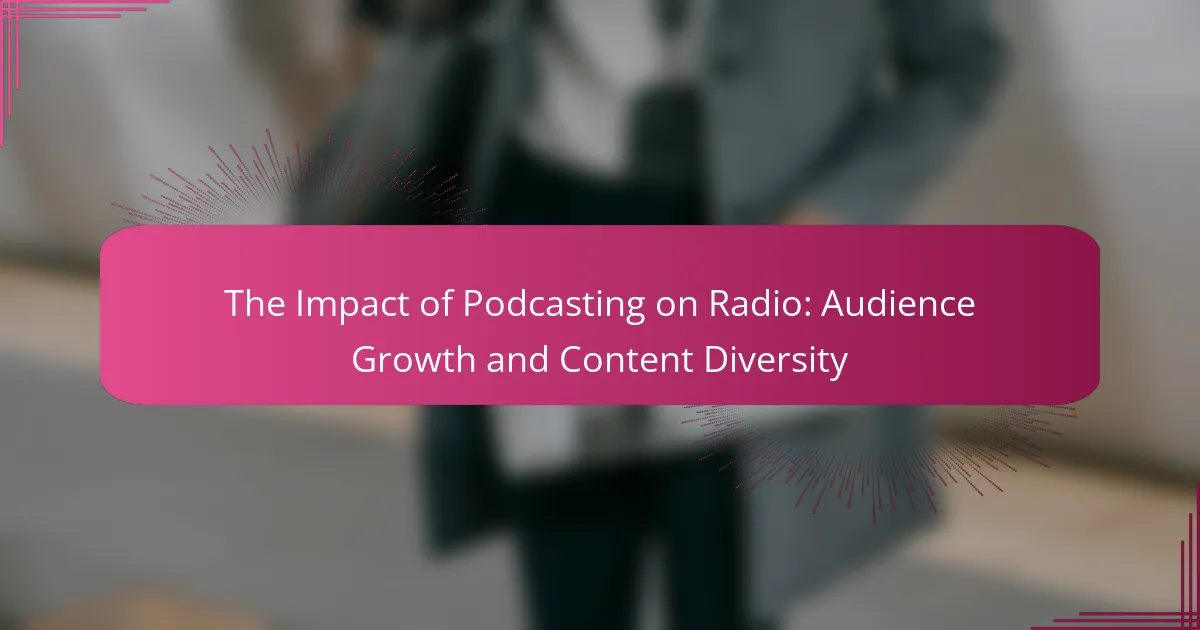Podcasting has emerged as a transformative force in the radio industry, significantly diversifying content and expanding audience reach. Unlike traditional radio, podcasts offer on-demand listening, appealing particularly to younger demographics that favor digital media. The rise of podcasting has prompted radio stations to adapt by creating their own podcasts, enhancing engagement and community building. Additionally, the shift towards on-demand audio has influenced advertising strategies, with advertisers increasingly allocating budgets to podcasts due to their targeted reach. As podcasting continues to grow, it presents both challenges and opportunities for radio, necessitating innovation and content diversification to retain audience relevance.

What is the impact of podcasting on radio?
Podcasting has significantly impacted radio by diversifying content and expanding audience reach. Unlike traditional radio, podcasts offer on-demand listening, allowing users to choose when and what to listen to. This flexibility has attracted a younger demographic that prefers digital content. According to Edison Research, 55% of Americans aged 12 and older have listened to a podcast.
Moreover, podcasts provide niche content that often caters to specific interests, which traditional radio may overlook. This has led to increased competition for listeners, prompting radio stations to adapt their programming. Many radio stations have begun to create their own podcasts to engage audiences and retain relevance.
Additionally, the rise of podcasting has influenced advertising strategies in radio. Advertisers are increasingly allocating budgets to podcasting due to its targeted reach and higher engagement rates. As a result, radio and podcasting are increasingly intertwined, with many stations embracing the podcast format to enhance their offerings and connect with listeners.
How has podcasting changed the landscape of radio broadcasting?
Podcasting has significantly transformed radio broadcasting by diversifying content and expanding audience reach. Traditional radio relies on scheduled programming, while podcasts offer on-demand listening. This flexibility allows listeners to choose topics that interest them at their convenience. According to Edison Research, 57% of Americans have listened to a podcast, indicating a growing audience. Podcasts also enable niche content that may not fit traditional radio formats. This shift attracts younger demographics who prefer personalized audio experiences. Furthermore, the low barrier to entry for podcast creation has democratized content production, allowing more voices to be heard. Overall, podcasting has reshaped how audiences engage with audio content.
What are the key differences between podcasting and traditional radio?
Podcasting and traditional radio differ primarily in format and accessibility. Podcasting allows on-demand listening, while traditional radio broadcasts at scheduled times. Podcasts are typically pre-recorded, enabling editing for quality. In contrast, traditional radio often features live programming, which may include real-time listener interaction.
Podcasts can be accessed through various platforms and devices, increasing their reach. Traditional radio is limited to specific frequencies and may not be available everywhere. Additionally, podcasts cover a wider range of niche topics, catering to diverse interests. Traditional radio generally focuses on broader audience appeal.
The podcasting industry has seen significant growth, with over 2 million podcasts available as of 2023. This growth contrasts with traditional radio, which has experienced a decline in listenership in recent years.
How do the formats of podcasting and radio differ in content delivery?
Podcasting and radio differ significantly in content delivery. Podcasts are typically on-demand, allowing listeners to choose when and where to listen. Radio broadcasts are scheduled, requiring listeners to tune in at specific times. Podcasts often feature niche topics, catering to specific audiences, while radio tends to offer broader content to appeal to a wider demographic. Additionally, podcasts can be edited for content and quality, whereas radio shows are often live and unedited. This flexibility in editing allows for a more polished final product in podcasts. Furthermore, podcasts are accessible via various platforms, while radio is limited to traditional broadcasting methods. These differences illustrate how podcasting provides a more personalized listening experience compared to radio.
Why is audience growth significant in the context of podcasting and radio?
Audience growth is significant in podcasting and radio because it directly influences revenue potential and content reach. A larger audience attracts advertisers, leading to increased sponsorship opportunities. According to Edison Research, 55% of podcast listeners are more likely to purchase products advertised on their favorite shows. This correlation between audience size and advertising revenue is crucial for sustainability. Additionally, audience growth enhances the platform’s credibility and visibility in a competitive market. It allows creators to diversify content offerings, catering to varied listener interests. As audience numbers rise, so does the potential for community engagement and listener loyalty. These factors collectively contribute to the long-term success of both podcasting and radio industries.
What demographic shifts are observed in podcast audiences compared to radio listeners?
Podcast audiences are generally younger and more diverse than radio listeners. Research indicates that 49% of podcast listeners are aged 12-34, compared to only 29% of radio listeners in the same age range. Additionally, podcast audiences show a higher percentage of college-educated individuals, with 45% holding a degree versus 30% among radio listeners. Ethnic diversity is also more pronounced in podcast audiences, with 38% identifying as non-white compared to 28% of radio audiences. This shift reflects changing media consumption habits, particularly among younger demographics who prefer on-demand content.
How does podcasting attract younger audiences that traditional radio struggles to engage?
Podcasting attracts younger audiences through its on-demand accessibility and diverse content. Unlike traditional radio, which follows a fixed schedule, podcasts allow listeners to choose when and what to listen to. This flexibility aligns with the lifestyles of younger demographics who prioritize convenience. Additionally, podcasts cover niche topics that resonate with specific interests, appealing to younger listeners seeking personalized content. A study by Edison Research found that 49% of Americans aged 12-34 listen to podcasts monthly, highlighting the medium’s popularity among this age group. Furthermore, the informal and relatable style of podcasting fosters a sense of community, making it more engaging for younger audiences compared to the often formal tone of traditional radio.
What role does content diversity play in the impact of podcasting on radio?
Content diversity enhances the impact of podcasting on radio by attracting varied audiences. Diverse content caters to different interests and demographics. This inclusivity increases listener engagement and retention. A study by Edison Research shows that 55% of Americans have listened to a podcast. This statistic indicates a growing audience for diverse content. Furthermore, podcasts allow niche topics that traditional radio might overlook. This flexibility encourages innovation in content creation. Consequently, radio stations can adapt by incorporating successful podcast formats. Overall, content diversity is crucial for expanding radio’s reach and relevance.
How has podcasting contributed to niche content creation in the audio space?
Podcasting has significantly contributed to niche content creation in the audio space by enabling creators to target specific audiences. This format allows for deep dives into specialized topics that traditional media often overlooks. According to a 2021 report by Edison Research, 80% of podcast listeners prefer content tailored to their interests. This demand has led to an explosion of niche podcasts covering everything from true crime to niche hobbies. The low barrier to entry for podcasting encourages diverse voices and perspectives. As a result, creators can explore unique subjects without the constraints of mainstream broadcasting. This has fostered a rich ecosystem of content that appeals to varied listener preferences. Overall, podcasting has democratized content creation, allowing niche topics to flourish.
What types of content are more prevalent in podcasts versus traditional radio shows?
Podcasts typically feature a wider variety of content compared to traditional radio shows. This includes niche topics, storytelling formats, and in-depth interviews. Podcasts often cater to specific interests, allowing for specialized content that traditional radio may not cover. For example, true crime, personal finance, and health discussions are prevalent in podcasts. Traditional radio tends to focus on broader topics like news, music, and general entertainment. A report from Edison Research indicates that 75% of podcast listeners prefer shows that explore specific subjects in detail. This highlights the growing demand for diverse content in the podcasting medium.
How do podcasting and radio influence each other?
Podcasting and radio influence each other through content sharing and audience engagement strategies. Radio stations often incorporate podcasting elements to reach younger audiences. This includes creating on-demand content that mirrors popular podcast formats. Conversely, podcasters sometimes adopt traditional radio techniques, such as live broadcasting and audience interaction. According to a 2021 Edison Research report, 41% of podcast listeners also listen to AM/FM radio. This overlap indicates a blending of audiences. Additionally, radio shows are increasingly being repackaged as podcasts, expanding their reach. Overall, both mediums are evolving together, enhancing content diversity and audience growth.
What trends signify the merging of podcasting and radio formats?
The merging of podcasting and radio formats is signified by several key trends. Firstly, traditional radio stations are increasingly producing podcasts. This allows them to reach audiences beyond their broadcast range. Secondly, podcasts are adopting live elements, similar to radio broadcasts. This includes live shows and audience interactions. Thirdly, radio stations are integrating on-demand content. This shift caters to listener preferences for flexible consumption. Additionally, cross-promotion between podcasts and radio shows is becoming more common. This strategy helps both mediums expand their audience base. Lastly, the use of analytics in both formats is growing. This data-driven approach enhances content personalization and engagement.

What are the benefits of podcasting for radio stations?
Podcasting offers several benefits for radio stations. It enhances audience reach by allowing content to be accessed on-demand. This flexibility attracts listeners who prefer to consume content at their convenience. Additionally, podcasting diversifies content offerings beyond traditional radio formats. Stations can explore niche topics that may not fit into their regular programming.
Moreover, podcasting fosters deeper engagement with audiences. Listeners often develop a stronger connection to hosts and topics in a podcast format. This can lead to increased loyalty and community building.
According to Edison Research, 41% of Americans aged 12 and older have listened to a podcast in the past month. This statistic reflects the growing popularity of podcasts, indicating a significant opportunity for radio stations to tap into new demographics.
Furthermore, podcasting can generate additional revenue streams through sponsorships and advertising. This financial benefit can support the station’s overall operations and growth. Overall, podcasting serves as a strategic tool for radio stations to expand their influence and adapt to changing media consumption habits.
How can radio stations leverage podcasting to expand their reach?
Radio stations can leverage podcasting to expand their reach by creating on-demand audio content. This allows them to engage audiences who prefer listening at their convenience. Podcasting also enables stations to reach niche markets that may not tune in to traditional broadcasts. By offering specialized content, radio stations can attract diverse listener demographics. Additionally, podcasting provides an opportunity for cross-promotion with other media platforms. This can increase visibility and draw in new listeners. Data shows that podcast consumption has grown significantly, with over 50% of the U.S. population listening to podcasts in 2023. Thus, integrating podcasting strategies can significantly enhance a radio station’s audience growth and content diversity.
What strategies can be implemented to integrate podcasts into existing radio programming?
Integrating podcasts into existing radio programming can be achieved through several strategies. First, radio stations can create companion podcasts for their shows. This allows for deeper discussions on topics covered during broadcasts. Second, stations can air selected podcast episodes during off-peak hours. This can attract new listeners who prefer on-demand content. Third, collaboration with popular podcasters can enhance content diversity. Partnering with established podcasters can draw their audience to the radio platform. Fourth, promoting podcasts on social media can increase visibility. Engaging posts can encourage listeners to explore both formats. Lastly, using audience feedback to tailor content can improve integration. Understanding listener preferences can guide content creation across both mediums. These strategies leverage the strengths of both radio and podcasting to enhance audience engagement.
How does podcasting enhance listener engagement for radio stations?
Podcasting enhances listener engagement for radio stations by providing on-demand content. This flexibility allows listeners to access shows whenever they choose. It caters to diverse listener preferences and schedules. Radio stations can create niche content that targets specific audiences. This tailored approach fosters a deeper connection with listeners. Additionally, podcasts can include interactive elements, such as listener feedback and participation. Statistics indicate that 80% of podcast listeners listen to all or most episodes, showing strong engagement. Ultimately, podcasting expands the reach and relevance of radio content in a competitive media landscape.
What challenges do radio stations face with the rise of podcasting?
Radio stations face significant challenges due to the rise of podcasting. The shift in audience preferences towards on-demand content reduces traditional radio listenership. According to a 2021 Nielsen report, podcasting reached 116 million listeners in the U.S., indicating a growing trend. This shift leads to decreased advertising revenue for radio stations. Advertisers are increasingly allocating budgets to podcasts, which can offer targeted audiences. Additionally, radio stations struggle with content diversity compared to the vast array of topics available in podcasts. The flexibility and niche content of podcasts attract listeners who seek specific interests. Lastly, competition for talent intensifies as podcasters often provide more creative freedom and higher revenue potential.
How can traditional radio adapt to the competitive landscape created by podcasting?
Traditional radio can adapt to the competitive landscape created by podcasting by integrating on-demand content and enhancing audience engagement. This includes offering podcast-style segments within their programming. Stations can create unique, serialized content that encourages listener loyalty. They should also leverage digital platforms to reach wider audiences. Engaging with listeners through social media can foster community and feedback. Additionally, collaborating with popular podcasters can attract new listeners. According to a 2021 report by Edison Research, 41% of Americans aged 12 and older listen to podcasts monthly, highlighting the growing audience. By embracing these strategies, traditional radio can remain relevant in the evolving media landscape.
What are the potential risks for radio stations in ignoring podcasting trends?
Radio stations risk losing audience share by ignoring podcasting trends. Podcasts attract a growing demographic that favors on-demand content. According to Edison Research, 55% of Americans have listened to a podcast. This shift indicates a significant audience preference for podcasting over traditional radio. Additionally, radio stations may miss opportunities for revenue diversification. The podcasting industry generated over $1 billion in advertising revenue in 2021. Failure to adapt could result in decreased relevance in the media landscape. Radio stations may also struggle to engage younger listeners who prefer digital platforms. Ignoring these trends can lead to a decline in listener loyalty and market position.

What are the future implications of podcasting on radio?
Podcasting will likely lead to significant changes in radio’s future landscape. As podcasting continues to grow, traditional radio may face declining audiences. In 2021, over 80 million Americans listened to podcasts weekly, indicating a shift in listener preferences. This trend suggests that radio stations may need to adapt by incorporating podcast-like formats. Additionally, the rise of on-demand audio content could challenge radio’s live programming model. Radio may increasingly focus on niche content to retain specific audiences. Furthermore, partnerships between radio stations and podcast creators could emerge to leverage both platforms’ strengths. This evolution emphasizes the need for radio to innovate and diversify content offerings.
How is technology shaping the future of podcasting and radio?
Technology is significantly shaping the future of podcasting and radio. Advancements in streaming services enhance accessibility for listeners. Artificial intelligence is improving content recommendations and personalization. High-quality recording equipment is becoming more affordable, enabling diverse creators to produce professional content. Mobile applications facilitate easy consumption of podcasts on-the-go. The rise of smart speakers is increasing the demand for audio content. Data analytics are allowing creators to understand audience preferences better. These innovations are driving audience growth and content diversity in both mediums.
What innovations are likely to emerge in podcasting that will affect radio?
Innovations in podcasting that may affect radio include enhanced interactivity and personalization. Features like listener polls and real-time feedback can engage audiences more deeply. Advanced algorithms will likely curate content tailored to individual preferences. This personalization can attract listeners away from traditional radio. Additionally, the integration of augmented reality may create immersive listening experiences. Such innovations can redefine how audiences consume audio content. The rise of subscription-based models can also influence radio’s advertising-driven revenue. These shifts may compel radio stations to adapt their formats and strategies.
How might audience preferences evolve in response to changes in podcasting and radio?
Audience preferences may evolve significantly as podcasting and radio continue to change. Increased access to diverse content through podcasts can attract listeners who seek niche topics. As traditional radio faces competition from on-demand audio, audiences may prefer the flexibility of podcasts. The rise of personalized recommendations in podcasting can lead to more tailored listening experiences. Data shows that podcast consumption has grown by 20% from 2020 to 2021, indicating a shift in listener habits. Additionally, younger demographics are gravitating towards podcasts over traditional radio. This trend suggests that audience preferences will increasingly favor platforms that offer convenience and variety. Overall, evolving technologies and content availability will likely reshape audience tastes in audio media.
What best practices should radio stations adopt in the age of podcasting?
Radio stations should adopt a multi-platform approach to remain relevant in the age of podcasting. This involves creating original podcast content that complements on-air programming. Engaging with audiences through social media enhances listener interaction and feedback. Utilizing analytics tools helps to understand audience preferences and tailor content accordingly. Collaborating with popular podcasters can expand reach and attract new listeners. Offering on-demand content allows flexibility for audiences to listen at their convenience. Finally, investing in quality production ensures that both radio and podcast content meet high standards. These practices can help radio stations grow their audience and diversify their content effectively.
How can radio stations effectively market their podcasts to attract listeners?
Radio stations can effectively market their podcasts by utilizing social media platforms. Engaging content on platforms like Facebook, Twitter, and Instagram can attract potential listeners. Collaborating with influencers can expand reach and credibility. Email newsletters can inform existing listeners about new podcast episodes. Cross-promotion on the radio station’s existing shows can drive traffic to the podcasts. Utilizing SEO strategies can improve visibility on search engines. Creating eye-catching graphics and promotional materials can enhance appeal. Hosting live events or Q&A sessions can foster community engagement and interest. According to Edison Research, 55% of podcast listeners discover new shows through social media, highlighting its effectiveness.
What content strategies can enhance the synergy between radio and podcasting?
Integrating radio and podcasting can be enhanced through cross-promotion. Radio stations can promote their podcasts during broadcasts. This encourages listeners to engage with on-demand content. Conversely, podcasts can feature segments or interviews from radio shows. This creates a bridge between both formats.
Utilizing social media is another effective strategy. Both platforms can share content to reach broader audiences. Engaging listeners through interactive content can increase loyalty. This strategy fosters a community around both radio and podcasting.
Content repurposing also plays a crucial role. Radio shows can adapt their content into podcast episodes. This maximizes the use of existing material. It caters to different listening preferences and habits.
Finally, collaborating on special projects can enhance synergy. Joint events or series can attract audiences from both mediums. This collaboration can lead to increased visibility and shared resources.
The primary entity of this article is podcasting and its impact on radio. The article explores how podcasting has transformed radio by diversifying content, expanding audience reach, and attracting younger demographics through on-demand listening options. Key discussions include the differences between podcasting and traditional radio formats, the significant audience growth in podcasting, and the challenges faced by radio stations in adapting to these changes. Additionally, it highlights strategies for radio stations to leverage podcasting to enhance listener engagement and maintain relevance in a competitive media landscape.
